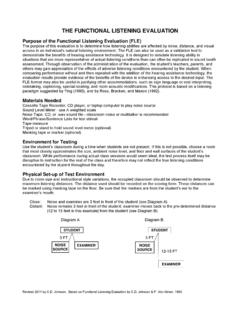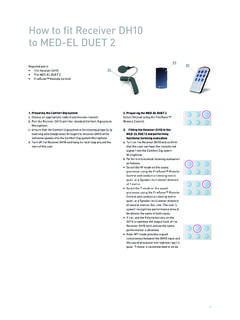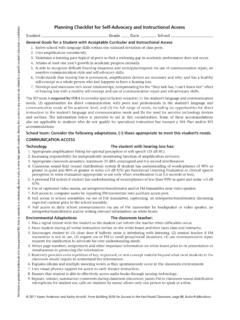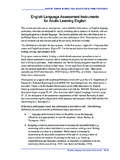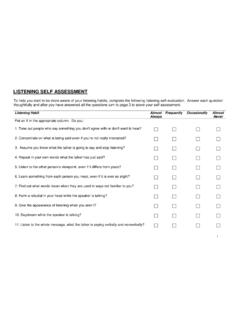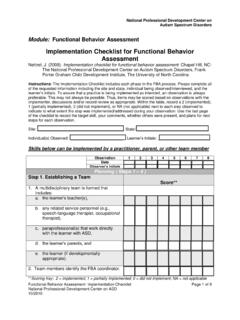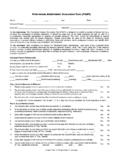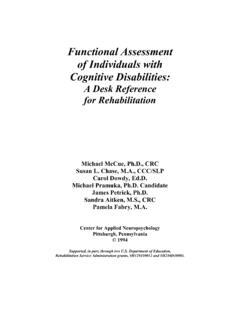Transcription of Clinical Skills for Assessing Velopharyngeal Function
1 Page 1 Clinical Skills for Assessing Velopharyngeal Functionby John E. Riski, Speech Pathology at Children's at Scottish to Develop Your Non-Instrumental Clinical SkillsHow can a speech-language pathologist assess Velopharyngeal Function without instrumentation?Many tools for screening Velopharyngeal closure are inexpensive and easy to use. The evaluationcan be considered as three components: Perceptual evaluation Clinical screening of Velopharyngeal closure Oral examinationCan these non-instrumental techniques be applied to other forms of velopharyngealincompetence (VPI)?Yes, these techniques can be used to assess Velopharyngeal Function caused by structural orneurologic disorders. They can be used to distinguish functional VPI from structural orneurologic EvaluationHow do I judge Velopharyngeal competency when listening to speech?Think pressure first. The purpose of the Velopharyngeal port is to produce oral listen for the oral pressure consonants such as p, b, d, s, etc.
2 The presence of thesesounds usually suggests some degree of Velopharyngeal competence whereas the lack of thesesounds may suggest a VPI. Then listen for hypernasality, nasal air escape and are compensatory articulations?Compensatory articulations are attempts by the speaker to create pressure consonants despite theloss of air pressure by Velopharyngeal incompetence. They are placement errors. Because theyare low-incident errors, clinicians, experienced with other disorders, do not develop experienceto recognize and treat 2 The most common compensatory articulations are: Glottal stops Pharyngeal fricatives Pharyngeal stops Posterior nasal fricative (previously labeled a nasal snort ) Anterior nasal fricative (facial grimacing) Co-articulation of oral and glottal stopCan speech output help me judge Velopharyngeal competency in a patient noncompliant fortesting?Listen for oral pressure consonants in the child s speech as suggested above.
3 The presence orabsence of certain sounds may suggest adequate or inadequate Velopharyngeal functioning. Also,you may be able to observe blowing in young children who are unwilling to speak. The ability toblow a whistle or birthday candles may suggest adequate Velopharyngeal functioning. Remember,blowing is not predictive of speech Skills , and blowing exercises do not help soft palate functionfor Screening of Velopharyngeal ClosureWhat are Clinical screening tests? Clinical screening tests assess Velopharyngeal closure for the oral sounds and velopharyngealopening for nasal sounds. Nasal resonance can be detected for the voiced sounds and nasal airemission for the unvoiced is the difference between Velopharyngeal closure and Velopharyngeal competence? Velopharyngeal closure is an all-or-none Function . Nasal air escape is present or it is competence refers to the fact that a small amount of nasal air leak may not affectspeech.
4 Thus, a speaker may have nasal air leak and lack Velopharyngeal closure, but may stillhave adequate oral pressure for speech sound can we learn from Clinical screening tests of Velopharyngeal closure? We can determine the consistency of closure. We can determine what sounds have Velopharyngeal closure. We can estimate the effort needed for Velopharyngeal a patient demonstrates hypernasality or nasal air escape or fails screening ofvelopharyngeal closure, refer to a competent cleft palate 3 What are the Clinical screening tests of Velopharyngeal closure?Three inexpensive and easy to use screening instruments SeeScape is a commercial device with a length of tubing, attached by an L-shapedconnector to a glass tube containing a Styrofoam piston. The end of the tubing is placed at thespeaker s most free-breathing nostril and the piston is viewed as the speaker repeats a speechsample containing oral pressure consonants.
5 The lightweight piece of Styrofoam moves upwith any nasal air entering the tube. The nasal listening tube or stethoscope can be made from a simple 18-inchlength of tubing, internal diameter of approximately 3/8 inch. One end is held to the patient snose and the other to the clinician s ear. Listen for inappropriate nasal resonance or nasal mirror test: A mirror can be held in position under the nose during an oral speechsample. Fogging of the mirror indicates nasal air the speech sample used in Clinical screening important?The speech sample is very important. When testing Velopharyngeal Function , the phonemes usedshould be developmentally appropriate. Early developing sounds are usually the mostappropriate. Short phrases or sentences are most appropriate, but single words are test for hypernasality, construct speech sample from: Oral consonants Voiced sounds High and low vowels Early appearing sounds For example, Buy baby a bib.
6 Nasal listening tube or stethoscope SeeScape Mirror testPage 4To test for hyponasality, construct speech sample from: Nasal consonants Voiced sounds (nasal sounds are voiced) Early appearing sounds For example, Mama made lemon jam. To test for nasal air emission, construct speech sample from: Oral consonants Unvoiced sounds (whispered if necessary this eliminates the confusing artifact of voicing) Early appearing sounds For example, Papa piped up. How do I assess the effect of VPI on articulation?Test the aspiration of each pressure sound with nose open, then with nose closed. Increasedaspiration (or oral air pressure) with the nose closed suggests VPI is affecting articulation andthat managing VPI will improve the quality of articulation. The same is true for the Velopharyngeal Mechanism by Oral-Facial ExaminationWhat is the innervation to the Velopharyngeal mechanism? The Velopharyngeal mechanism is enervated through the pharyngeal plexus Motor primarily by CN X (Vagus) Sensory by CN IX (Glossopharyngeal) The exception is the Tensor Palatini muscle, which is enervated by CN V (Trigeminal) What judgments can be made of Velopharyngeal Function from oral exam?
7 The symmetry of elevation The placement of velar dimple should be just above uvula, at distal 1/3 and anterior 2/3 s ofsoft palate The structure of the velum including bifid uvula, submucous cleft and posterior nasal spine Fistula will not affect resonance if below point of Velopharyngeal closure Submucuous cleft/bifid uvula Bifid uvula: the incidence may be as high as 1/70 What are the characteristics of submucous cleft palate? Bifid uvula Zona pellucida Notch into posterior hard palate Anterior velar dimple Page 5 What judgments cannot be made of Velopharyngeal Function from oral exam? Velopharyngeal closure Nasopharynx size Pattern of closure Are there reasons, other than paralysis, that cause the velum not to elevate? Nasal vowel corrected by /ka/ Gag elicited breathe through nose Prominent adenoids or shallow nasopharynx (speaker will be hyponasal) Levator attached anteriorly or on nasal side of velum Where should I refer a patient who is consistently hypernasal and/or fails screening tests ofvelopharyngeal closure?
8 This individual should be referred to a cleft palate team. adapted from: John E. Riski, Speech Pathology at Children's at Scottish questions concerning clefts contact:Dr. Luis Cuadros, Plastic SurgeryNew Mexico Cleft Palate Study Center8232 Louisiana NE, Suite AAlbuquerque, New Mexico 87113tel 505-243-7670fax 505-242-0510email
